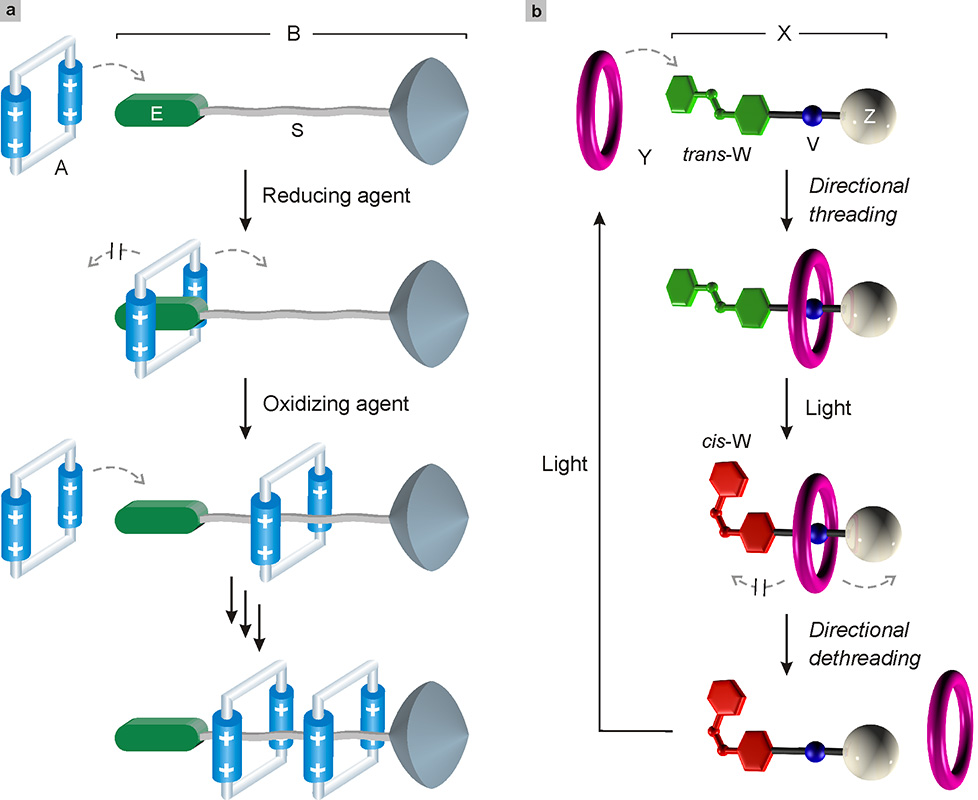4.4. Molecular machines to convert (solar) energy
In Chapter II we described the functioning of the ATP synthase (Fig. 13). This nanomachine exploits the difference in hydrogen ion concentration between two solutions separated by a membrane to produce ATP, a substance with a high energy content. In practice, therefore, it converts one form of chemical energy into another. The use of artificial molecular machines to transform and store energy is not only interesting from a conceptual point of view, but also potentially very important from the application point of view. Some significant steps in this direction were made in 2015 by Fraser Stoddart’s group at Northwestern University (USA) and in our laboratory at the University of Bologna.
With a skillful design, Stoddart and collaborators were able to build a molecular strand B consisting of an end E capable of inserting and transferring molecular rings A in a unidirectional manner by exploiting a chemical reaction, a thread-like portion S without stations for the rings, and an end cap T (Fig. 29a). Following reduction and oxidation processes, caused by reagents added to the solution in which the molecular machine is dissolved, the rings are pushed along the filament and transferred to the thread-like portion S which acts as a “reservoir”, where they remain trapped (Cheng 2015)1Cheng, C., McGonigal, P. R., Schneebeli, S. T., Li, H., Vermeulen, N. A., Ke, C., Stoddart, J. F. (2015) An artificial molecular pump, Nature Nanotechnology, 10: 547-553.. Such a system behaves like a real molecular pump that converts the energy of the redox reaction into another form of chemical energy, represented by the high concentration of molecular rings in the reservoir.

At the same time in our laboratory we built a molecular pump that uses light energy (Ragazzon 2015)2Ragazzon, G., Baroncini, M., Silvi, S., Venturi, M., Credi, A. (2015) Light-powered autonomous and directional molecular motion of a dissipative self-assembling system, Nature Nanotechnology, 10: 70-75.. The system (Fig. 29b) consists of a solution containing molecular filaments X and molecular rings Y. The filament X contains a –N=N– unit (W), which can change shape (from trans, linear, to cis, bent; see Fig. 18) following the absorption of photons of light, a station V for the ring, and a bulky terminal group Z. When the component W is in the linear trans form, the ring passes over the filament crossing W to reach the V station. Following the absorption of a photon of blue light, the W unit passes to the much more cumbersome cis form; consequently, the ring must leave the filament crossing the end Z. The subsequent arrival of another photon, identical to the previous one, restores the trans form of the W unit, thus closing the cycle. This sequence of processes, and the consequent unidirectional transit of the ring with respect to the filament, is repeated until the solution is illuminated with blue light. It should be emphasized that the molecular device, at present, dissipates light energy without converting it into a useful form, because the rings are transferred in the same solution from which they are taken. However, it is potentially capable of transforming solar energy into chemical energy, if the rings are transferred between distinct compartments, as in the case of the system illustrated in Figure 29a.
Of course, the construction of molecular machines that allow the exploitation of solar energy is not around the corner. There are many complex problems to solve; last but not least, how to use the chemical energy accumulated by nanomachines. The problem is really fascinating: it is about realizing an artificial photosynthesis, which however works in a substantially different way compared to photosynthesis in plants and bacteria. Since the future of our civilization depends on the solution of the energy problem, the challenge is too important not to be taken up.


